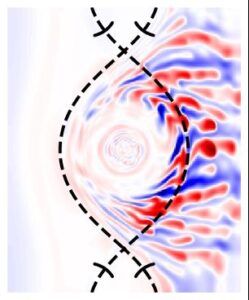Originally published on 19.10.2023

“These grants are instrumental in fostering a new generation of scientists who are at the heart of advancing fusion energy research in Switzerland and the rest of Europe”, said Eva Belonohy, EUROfusion Training and Education Officer. In other words, the primary goal of the EUROfusion Bernard Bigot Researcher Grants program is to enhance the professional development of exceptional post-doctoral researchers. This is achieved by providing assistance for groundbreaking research initiatives that are in line with Europe’s Fusion Energy Roadmap. The grant significantly subsidizes researchers’ salaries and research-related activities for up to two years, facilitating in-depth exploration of selected fusion science and engineering challenges, thereby accelerating Europe’s progress towards realizing fusion energy.
Reducing divertor heat load is considered among the most pressing issues to the success of fusion energy
Kyungtak’s project, titled “Investigation of the plasma dynamics in the boundary of double-null (DN) tokamak configurations”, explores an area noted for its critical importance in the Eurofusion Roadmap. Kyungtak explains, “Reducing divertor heat load is considered among the most pressing issues to the success of fusion energy. The TCV tokamak, located at the SPC, is internationally recognized for its pioneering efforts in exploring alternative heat exhaust configurations, especially the double-null. Observing its growing interest and recognizing a gap in our physical understanding, I was motivated to explore the potential of DN tokamak configurations.”
The double-null is a particular tokamak configuration that aims to address challenges related to heat exhaust on divertor targets—a crucial hurdle in making fusion energy a viable power source. This configuration is operational in many of the present worldwide tokamaks and is also planned for future tokamaks, showcasing its importance in the fusion energy landscape.
In the double-null configuration, the heat load is distributed among four different divertor legs. The physical mechanism of power sharing remains unclear, which makes it difficult to predict its viability for heat exhaust in larger machines. Kyungtak’s research project aims to advance our understanding of the physical mechanisms that determine power sharing and to assess the potential of the double-null as a viable exhaust solution for future fusion devices.
The ERG grant is a significant milestone in my research career.
Kyungtak Lim now joins a cohort of accomplished scientists who have been recognized through the ERG programme. On receiving this recognition, Kyungtak shared, “The ERG grant, the most prestigious award that the worldwide fusion program offers to early-career researchers, is a significant milestone in my research career. The recognition from the ERG grant will enable me to collaborate with leading experts in this field, facilitating more comprehensive studies that will enhance my current research endeavours.”
With Switzerland and Europe at the cusp of pioneering advancements in fusion research and technology, Kyungtak’s research represents a leap forward towards a sustainable and clean energy future. Kyungtak acknowledged, “My research project aims to provide a significant contribution by evaluating the viability of the DN as an exhaust solution for future devices beyond ITER, thereby advancing the progress of the entire fusion program.”
Spending nearly two years at SPC has been an enriching experience
With recognitions like these, EPFL’s Swiss Plasma Center further cements its substantial footprint on the global fusion research domain, continuing its legacy of nurturing scientific talent and innovation. Kyungtak reflected on his experience at the SPC, saying, “Spending nearly two years at SPC has been an enriching experience. Being surrounded by leading and passionate researchers and colleagues has not only motivated my research but also boosted my ambition to become a fusion scientist.”
EUROfusion, with its collaborative approach and initiatives like the ERG (ERG), represents the teamwork needed to tackle the complex challenges on the journey towards attaining fusion energy. Through their support of talented researchers like Kyungtak Lim, EUROfusion and the Swiss Plasma Center are working together to bring us one step closer to a future where pollution-free, abundant, and safe energy is accessible to all.
Understanding Double-null Tokamak Configurations
In the pursuit of controlled nuclear fusion as a clean and plentiful source of energy, researchers employ devices known as tokamaks. A tokamak is a machine designed to confine hot, charged gas, called plasma, in a donut-shaped vacuum chamber using magnetic fields. By doing so, it allows the conditions for nuclear fusion to occur, much like the processes powering our Sun.
A crucial aspect of managing this plasma includes mitigating the amount of heat flux that reaches the wall of the tokamak and overseeing its interaction. This is essential to prevent damage to the machine and to sustain the required conditions for fusion. Within a tokamak, the divertor is a specialized region designed to handle the heat and particle flux coming from the edge plasma. The formation of this divertor requires the presence of null-points, where the magnetic field lines intersect and close upon themselves.

In a double-null tokamak configuration, there are two such null points – one at the top and one at the bottom of the tokamak. This leads to four divertor legs, as opposed to the two legs in single-null tokamak configuration. This configuration is preferred for its potential benefits in plasma stability and control. By having two null points, the configuration aims to distribute the plasma-wall interactions more evenly, potentially reducing the wear on the tokamak wall and enhancing the conditions for sustained fusion reactions.
The exploration of plasma dynamics within these double-null configurations is pivotal. By understanding and optimizing the behaviour of plasma in these configurations, researchers like Kyungtak Lim hope to solve some of the persistent challenges in fusion energy, inching closer to making fusion energy a viable and sustainable energy source.
Short biography
2009 – 2015: Bachelor in Physics, magna cum laude, Hanyang University, Seoul, South Korea
2016 – 2018: Master in Physics of Plasmas and Fusion (PPF), magna cum laude, Université Paris-Saclay, Orsay, France
2018 – 2021: PhD student in plasma physics, Institut Jean Lamour (IJL), Nancy, France
Since 2021: Postdoctoral researcher in Plasma Edge Theory group, Swiss Plasma Center (SPC), EPFL, Lausanne, Switzerland

